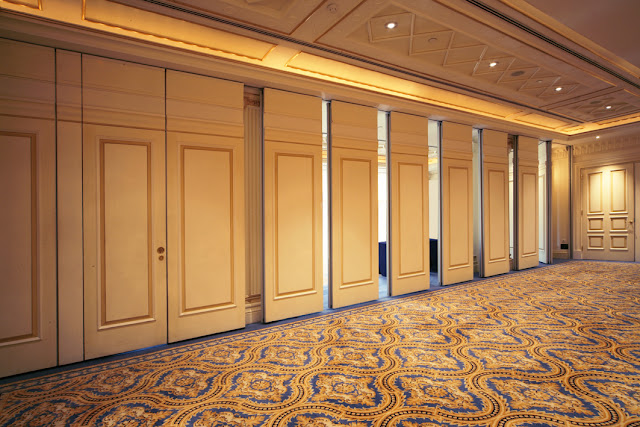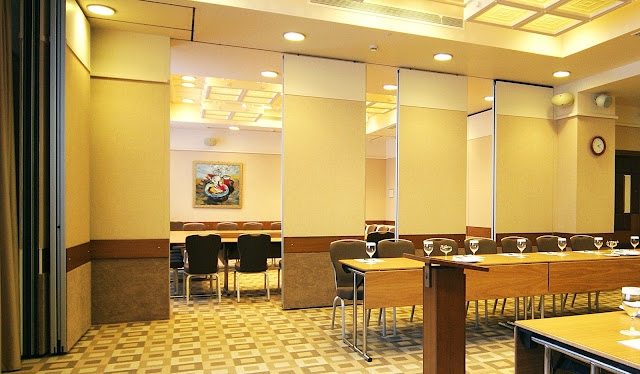Η Ηχομόνωση των Κινητών Τοίχων και σχετικές έννοιες
Η ηχομόνωση των κινητών τοίχων είναι από τις πλέον σημαντικές ιδιότητες. Επειδή διαχωρίζουν ανεξάρτητες δραστηριότητες που συνήθως δημιουργούν ήχους, είναι σημαντικό οι ήχοι από κάθε πλευρά να μη φθάνουν στη διπλανή αίθουσα και προκαλούν ενόχληση. Αναλόγως των δραστηριοτήτων που πρόκειται να διαχωρίζουν συνήθως, επιλέγεται και ο κατάλληλος βαθμός ηχομόνωσης. Για την επιλογή του βαθμού ηχομόνωσης λαμβάνονται υπ' όψη πολλές παράμετροι, όπως (ενδεικτικά):
- · Είδος εκδηλώσεων που αναμένονται. π.χ. μια συζήτηση γύρω από ένα τραπέζι δημιουργεί πολύ λιγότερο θόρυβο από μία τάξη μικρών παιδιών.
- · Οι συχνότητες του ήχου που θα παράγεται. Οι χαμηλές συχνότητες απομονώνονται πολύ δυσκολότερα από τις υψηλές. Έτσι μία τάξη εφήβων απαιτεί μεγαλύτερη ηχομόνωση από μία τάξη ίδιου αριθμού νηπίων.
- · Εάν χρησιμοποιούνται μεγαφωνικές εγκαταστάσεις, αυτές παράγουν πολύ υψηλότερες στάθμες ήχου και απαιτούν καλύτερη ηχομόνωση.
- · Εάν οι χώροι βρίσκονται σε σημείο όπου μεταφέρεται διαρκής εξωτερικός θόρυβος (π.χ. Κυκλοφορία βαρέων οχημάτων), αυτός αναμένεται να καλύψει, σε κάποιο μέτρο, την ηχητική ενόχληση από το παραπλεύρως μέρος της διαχωρισμένης αίθουσας. Εάν έχουμε μεγάλη ησυχία απαιτείται μεγαλύτερη ηχομόνωση.
- · Το μέγεθος των αιθουσών είναι πολύ σημαντική παράμετρος. Όσο πιο κοντά στον κινητό τοίχο θα βρίσκονται οι πηγές ήχου (αλλά και τα πρόσωπα-δέκτες στην άλλη πλευρά), τόσο μεγαλύτερη ηχομόνωση απαιτείται. Επίσης το ύψος των κινητών τοίχων είναι σημαντικός παράγοντας, μια και συνήθως ένα μέρος της ηχητικής ενέργειας διαρρέει μέσα από ψευδοροφές. ‘Οσο πιο ψηλά βρίσκεται η ψευδοροφή από το δάπεδο, τόσο περισσότερο εξασθενεί ο ήχος, που έχει να διανύσει την διπλάσια απόσταση μέχρι να φθάσει στον ακροατή (μέσω της ψευδοροφής).
- · Τέλος, σημαντικός είναι και ο παράγων «κόστος». Η υψηλή ηχομόνωση κοστίζει περισσότερο και γι' αυτό συνήθως προσπαθούμε να κάνουμε ένα συμβιβασμό μεταξύ των εμπλεκομένων παραμέτρων.
Η ηχομόνωση σε κάθε κινητό τοίχο (αλλά και σε κάθε ηχομονωτικό οικοδομικό στοιχείο), εξαρτάται από τη κατασκευή και τα υλικά που έχουν χρησιμοποιηθεί για τη κατασκευή του. Η ηχομόνωση εκφράζεται σε μονάδες της κλίμακας “Decibel” η οποία είναι λογαριθμική. Αυτό σημαίνει ότι μικρή μεταβολή στη τιμή της ηχομόνωσης μπορεί να σημαίνει πολύ μεγάλη διαφορά στο αποτέλεσμα. Για τη πιστοποίηση της τιμής κάθε κινητού τοίχου γίνεται δοκιμή σε ειδικά εργαστήρια που έχουν διαπίστευση (δηλαδή εξουσιοδότηση) για να κάνουν τέτοιες δοκιμές. Οι μετρήσεις απαιτούν ειδικά όργανα και ειδικά διαμορφωμένους χώρους. Τα εργαστήρια εκδίδουν πιστοποιητικά τα οποία περιγράφουν τον τρόπο των μετρήσεων, το υλικό και τη σύνθεση του, τις καμπύλες ηχομόνωσης συναρτήσει των συχνοτήτων (συνήθως από 100 έως 3.000 Hz), καθώς και το πρότυπο βάσει του οποίου έγιναν (τα πρότυπα διαφέρουν κάπως στην Ευρωπαϊκή ένωση από άλλες περιοχές του κόσμου). Στην ΕΕ το σχετικό πρότυπο είναι το ΕΝ 717-1:2006. Πρέπει να τονιστεί ότι τα πιστοποιητικά της ηχομόνωσης αναφέρονται σε ορισμένες διαστάσεις δείγματος και εργαστηριακές συνθήκες που είναι ιδανικές και δεν είναι δυνατόν να επαναληφθούν σε ένα συνηθισμένο κτήριο. Στη πράξη γίνεται προσπάθεια να προσεγγισθούν, κατά το δυνατό, οι εργαστηριακές συνθήκες, αλλά μόνο εν μέρει επιτυγχάνεται αυτό. Στο παρακάτω σχέδιο φαίνονται οι πιθανές διαρροές ήχου σε μία πραγματική κατασκευή:
***
Sound insulation of Movable Walls and relative concepts
The sound insulation properties of movable walls is one of their
most significant attributes. As they are used to divide events taking place in
adjoining rooms, that are, most often, producing sounds, it is crucial that the
sounds produced from each side are not transmitted to the other side and cause
disturbances. Depending on the kind of activities that the movable walls are
intended to separate, the appropriate degree of sound insulation is to be
selected. For the selection of the appropriate sound insulation figure (sometimes
referred to as “sound reduction”) several factors should be considered, such
as:
·
Type of activities expected. For example a
round-table discussion is expected to generate a lot less loud sounds than a
class of small children.
·
The sound frequencies that are expected. Low
frequencies are much more difficult to attenuate than high frequencies. A class
of adolescents requires much better sound insulation than a class of nursery
school of the same number of children.
·
If public address systems are used the sound
intensity produced is much higher and, therefore, higher sound insulation is
required.
·
If the spaces are located e.g. at a point where heavy
traffic sounds are continuously transmitted through windows (or poorly
insulated masonry) this noise is expected to mask, to some extent, sounds transmitted
through the movable wall from the adjoining room. If all is quiet, higher sound
insulation is required.
·
Another significant factor is the size of the spaces
formed. The closer the sound sources are to the movable wall (and the persons
receiving the sound on the other side) the higher sound insulation is required.
The height of the movable walls is also a significant factor, as part of the
sound energy usually leaks through false ceilings and the plenum above them.
The higher the false ceilings are placed, the more attenuated the transmitted
sound is, as it has to travel twice the distance to reach the “listeners” on
the other side of the wall.
·
Last, price is an important consideration.
Higher sound insulation costs more and, for that reason, we usually try to find
a compromise among all the parameters involved.
The effective sound insulation in a movable wall (and in
every sound reducing building element) depends on the entire structure and the
materials that have been used. Sound insulation is measured in “Decibel” units (“dB”
for short) which is a logarithmic unit. This means that a small change in the
value of the sound insulation may actually mean a very large difference in sound
intensity.
For the official certification of a sound insulating
element, such as a movable wall, a test is performed in specially built
laboratories that were accredited (authorized) to make such tests and issue sound
insulation certificates. Tests require special equipment and spaces. The
laboratories issue certificates that describe the mode of measurement, the
materials tested and their composition, the sound insulation graphs obtained as
a function of frequency (typically 300-3000 Hz), as well as the standard according to which the
test was made. (The standards are somewhat different in European Union
countries from other countries). The standard used in the EU is EN 717-1:2006.
It must be emphasized that the sound insulation certificates are based on fixed
sample sizes and laboratory conditions which are ideal and cannot be
repeated in actual situations. It is standard practice to try to approximate laboratory
conditions as much as possible, but this
is only partly possible. In the following image, the possible sound leak paths,
in a practical construction, are shown:

Και μερικές φωτογραφίες ακόμη:
Some more photos:
 |
Η διαδικασία κλεισίματος ή ανοίγματος του Κινητού Τοίχου
Closing or expanding the Movable Wall |
 |
Κινητός Τοιχος σε συνεδριακή αίθουσα σε ξενοδοχείο της Βόρειας Ελλάδας
Movable wall in conference room in Hotel in Northern Greece
|
 |
Δύο Κινητοί Τοίχοι σχηματίζουν "φουαγιέ" που εξυπηρετεί δύο συνεδριακές αίθουσες
Two Movable Walls form an antechamber between two conference rooms
|































